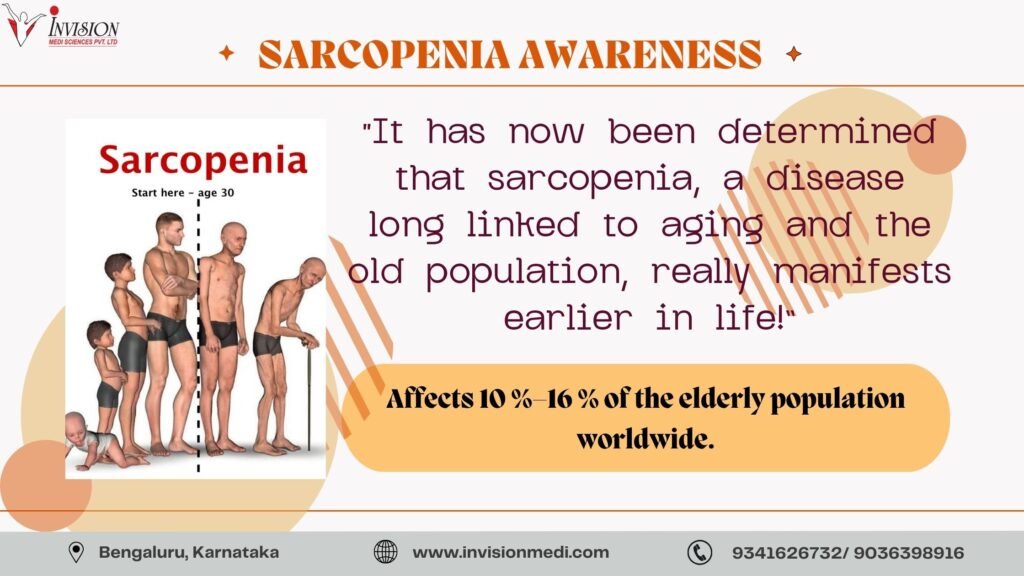
Breaking down Sarcopenia

Sarcopenia is a geriatric (old-age) syndrome that displays a cumulative degeneration of skeletal muscle mass and function, physical disability, a decrease in quality of life, and an increased mortality risk.1 The term is procured from the Greek wordssarx,’ meaning flesh, and ‘penia, meaning loss. It affects 10%–16% of the elderly population worldwide.7
Delving into the Major Root Causes Influencing Muscle Loss
Lifestyle Behaviour: Smoking and reduced exercise as a result of sedentary lifestyles may raise the chance of developing sarcopenia.5, 3
Aging Factors and Metabolical Changes: Age-related alterations in the angiotensin system, mitochondria, and apoptosis lead to a decrease in neuromuscular junctions and hormone synthesis.3, 7
Low Body Mass Index and Daily Protein Intake: Less than 1.2 g/kg of protein per day is thought to be linked to an increased incidence of sarcopenia.4
Gender Factor: Sarcopenia is linked to a higher risk of death in older women.4
Health Status: Chronic diseases such as cancer, heart failure, and rheumatism cause high levels of inflammatory cytokines, which can lead to sarcopenia and a decrease in skeletal muscle mass.3

The Varied Shades of Sarcopenia
Primary sarcopenia is the diagnosis made when age is the only apparent cause. It is labeled as secondary sarcopenia when factors other than aging become apparent, such as systemic disorders like organ failure or cancer. 2

Classification based on severity by the Asian Working Group for Sarcopenia (AWGS)
- Possible sarcopenia is characterized by either low muscle strength or low physical performance.
- Sarcopenia is defined as having both low muscle mass and low muscle strength or low physical performance.
- Severe sarcopenia encompasses all three aspects: low muscle mass, low muscle strength, and poor physical performance. 2
Impact of the Muscle Thief
High rates of cognitive decline, osteoporosis, falls, fractures, functional decline, hospitalization, metabolic syndromes, diabetes, non-alcoholic liver disease, liver fibrosis, hypertension, depression, and dysphagia (difficulty swallowing) are linked to the consequences of this muscle killer. 7
Unraveling the Convention on Diagnosis!
2019 AWGS Criteria That Facilitate Earlier Identification of People At Risk For Sarcopenia
To identify sarcopenia, muscle strength, physical performance, and skeletal muscle mass must be evaluated.
· Low muscle strength
Handgrip strength: <28 kg for men and <18 kg for women
Calf circumference: (<34 cm in men, <33 cm in women)
Gait speed: < 1 m/s
· Low physical performance
6-m walk <1.0 m/s
· Short Physical Performance Battery score
≤9, or 5-time chair stand test ≥12 seconds, 2, 5
When are you at risk?
“According to research, skeletal muscle mass and strength decrease linearly starting in the fourth decade of life and can reach 50% loss by the eighth decade.”
Adults lose 3–8% of their muscular mass every ten years after the age of thirty. Ages 60 and older are the most common age group affected by sarcopenia. As people age, rates rise. 6, 7
Medical Intervention
Sarcopenia can be treated with hormone replacement therapy (TRT) and selective estrogen receptor modulators (SERMs), which promote muscle fiber hypertrophy and fat-free mass in postmenopausal women. Other potential targets include PGC-1A, PDE, skeletal muscle stem cells, and gene recombination, with drugs like metformin, anti-myostain activin ii receptor, estrogen, and angiotensin-converting enzyme inhibitors being studied.
Efficacy of Exercise and Dietary Supplements for Healthy Muscles
Aerobic exercise improves muscle vascularity and mitochondrial function, protecting against sarcopenia. Resistance training promotes greater muscle volume and boosts myokine synthesis, impacting muscle growth.
Combining high-quality, protein-rich meals with exercise increases muscle mass, strength, and function. Nutritional supplements, such as protein, amino acids, and creatine, can maintain muscle protein synthesis and reduce inactivity-induced muscle loss.
Final Thoughts
Research has shown that the development of sarcopenia takes a long time and does not appear on short notice. So considering the factors that may give rise to muscle disorders like sarcopenia, people need to have an active lifestyle. Indulging in a workout routine paired with proper nutrition is important to watch out for stealthy muscle deterioration disorders like sarcopenia. Although there is no known cure for sarcopenia, certain supplements might be beneficial, especially when used in conjunction with exercise.
REFERENCES
1. Front Med (Lausanne). 2021; 8: 739251. 2. Sci Rep. 2020; 10: 19551. https://www.ncbi.nlm.nih.gov/pmc/articles/PMC7658996/ 3. Cells 2022, 11(15), 2359; https://doi.org/10.3390/cells11152359 4. Nutr Res. 2022 May:101:14-22. doi: 10.1016/j.nutres.2022.02.002. Epub 2022 Feb 18. 5. Arch Public Health 78, 113 (2020). https://doi.org/10.1186/s13690-020-00498-9 6. Curr Opin Rheumatol. 2012 Nov; 24(6): 623–627. doi: 10.1097/BOR.0b013e328358d59b 7. Metabolism. 2023 Jul:144:155533. https://doi.org/10.1016/j.metabol.2023.155533
FAQs
Sarcopenia: a disease of the bones?
Sarcopenia is not a bone problem, it is a debilitating musculoskeletal disease usually associated with age; it is a condition marked by the loss of muscle mass, strength, and function.
Difference between Sarcopenia and osteoporosis?
Muscle mass and function are rapidly lost in sarcopenic disease, a progressive widespread skeletal muscle degeneration. A systemic skeleton disorder called osteoporosis causes poor bone mass and quality.
Is it possible to cure sarcopenia?
Sarcopenia lacks a cure, but supplements like protein, amino acids, fish oil, vitamin D, selenium, magnesium, and omega-3 fatty acids may prevent muscle loss, especially when combined with exercise.
How can one treat sarcopenia?
As per recent clinical trials, therapies such as physical exercise, and nutraceutical, and pharmaceutical interventions are effective in alleviating sarcopenia.
Is sarcopenia a genetic disease?
Research indicates that sarcopenia is not only a hereditary condition. It is a disorder that is usually linked to aging and is characterized by a decrease in muscular mass and strength. Its development is influenced by environmental as well as genetic factors.
What are the top or early signs of sarcopenia?
Apart from getting older, other factors that raise a person’s risk of sarcopenia include inactivity, insufficient exercise, and bad diet. Falling, muscle weakness, a sluggish gait, muscle atrophy, and trouble carrying out daily tasks are among the symptoms of the illness.
Is Sarcopenia only seen in old age?
While sarcopenia is predominantly an age-related illness, factors such as malnourishment, cachexia, and lack of exercise may contribute to the development of sarcopenia. It can also be observed in younger people, such as those with inflammatory disorders, similar to osteopenia.
Is exercise capable of reversing sarcopenia?
According to experts even the elderly can achieve significant increases in strength and muscular hypertrophy through progressive resistance training.
Bioferol-D3, OGF-3, ODF-3G, OGF-4G Soft Gels, Aminut, Chelated Magnesium Complex Tablets, Essentio, and CaHMB are just a few of the potent muscle-building supplements distributed by Invision Medi Sciences. Promising outcomes in stopping muscle loss have been observed with our products, which are enhanced with protein, amino acids, fish oil, vitamin D, selenium, magnesium, and omega-3 fatty acids.


